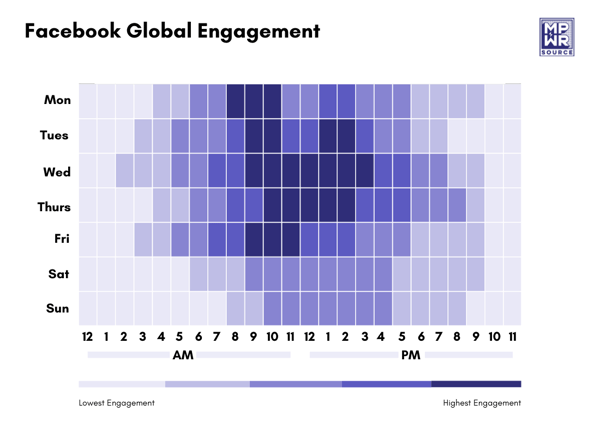Social Media Marketing for Small Business
Social media marketing can be overwhelming for small businesses but it can and...

A new year is approaching and now is the perfect time to set some new goals. It’s time to really elevate your social marketing strategy.
Our digital world is often a fight to the pain for your audience’s attention and social media is an excellent way to engage with your market. It can help you know what matters to them, what isn’t working for them, and ultimately, how your organization can better serve them.
But how?
We’ve put together some helpful tips for you to get your social media strategy off the ground and headed in the right direction.
No matter if you’re an old pro or just starting up your following, these tips can help you prioritize your efforts and make a greater impact.
For MPWRSource, it always ALWAYS comes down to strategy. Our plans have plans and we never leave our Superhero lair without a battle plan.
Effective social media strategy always begins with asking why. What do you want to gain from social media anyways?
The most common goals for social media are increasing brand awareness and increasing community engagement. Whether you want a larger following and more name recognition or a more active community of followers, taking the time to really define your goals and mission is the first step in the evolution of success.
Your social media goals should be realistic for your business. By tackling smaller objectives, you will be better able to scale your efforts effectively (read: affordably).
Here are some reasonable goals that social media marketing can achieve for you.
This means getting your name out there and positioning yourself as a thought leader. This does NOT mean simply posting about your products and services. You aren’t on social media to sell but rather to engage, educate, and yes, entertain your audience. Focus on content that shows your market WHY they should look to you for solutions.
Today’s buyer’s journey is largely conducted online. Buyers research before they buy. Is your social media informing your buyers about products and services that can help them? Are you running exclusive deals for your followers? Are you answering their questions?
Gaining followers means finding new ways to introduce your organization to new people who may have not heard of you before. It also means discovering conversations into which your brand can speak authoritatively and helpfully. Using social listening tools can really help you have a pulse on the conversations that matter most to your target market.
Brands that engage their audience well are thought of positively. This means experimenting with content and messaging as well as highlighting and encouraging user-generated content and hashtags.
Whether through promotional posts or targeted ads, keeping an eye on conversions and URL clicks can help you determine your ROI from social media. When in doubt, it is better to focus on one channel and do it well before branching out onto multiple platforms.
 Research Your Target Audience
Research Your Target Audience No matter the context, it is always wise to know to whom you are talking. This is even more important when dealing with social media. Different social media channels attract different audiences. There are roughly 4.5 billion people worldwide who are active on social media, but you probably don’t want to speak to all of them. So how do you decide?
Having well fleshed out buyer personas is a good start. This is the first step in an effective social media strategy. Facebook and You Tube attract high-earning users. Instagram is a hotbed for Millennials and Gen Z, as 64% of its users are under the age of 34. Women love their Pinterest accounts. LinkedIn users are well-educated and prefer industry-specific content. Twitter? Twitter is the wild west and everyone is screaming. Twitter also requires the most posts/tweets to be effective. Think multiple posts per day that require active social listening.
You have your goals. You have your buyer personas. And you’ve figured out what channels your people are using. So…. now what? How do you even know that your social media content is working? Metrics. For MPWRSource, the answer to most questions is “look at the data”.
Post reach is the number of unique users who saw your post. How far is your content spreading? In the world of ever-changing social media algorithms, tracking reach is important.
This is the number of clicks on your content, company name, or logo. These clicks are pivotal in determining how your users are moving through your sales journey and it helps determine how your campaigns are engaging users.
This number represents the total number of social interactions divided by the number of impressions. This lets you know who interacted and if it was a good ratio out of your total reach.
What hashtags are most associated with your brand? Which hashtags create the most engagement? Which hashtags are you using the most and with the most success? This can help you determine future content.
Organic traction is much harder to use to gain traction due to algorithms which is why many organizations turn to Facebook Ads. However, because of its broad use of hashtags, organic reach goes further on Instagram. Knowing these differences will allow you to invest wisely in different formats.
 Create (and Curate) Engaging Social Content
Create (and Curate) Engaging Social ContentGood social media strategy relies upon good content. After all, your content is what you will be sharing.
Create content that is helpful and human. Even if you are in the business-to-business world, you will be using social media to establish relationships will humans. You want your content to attract, engage, and delight your audience, ever propelling your prospects further along in the buyer’s journey.
Different channels lend themselves to different types of content. Videos and reels are perfect for Facebook and Instagram. Case studies, blogs, and infographics are perfect for LinkedIn. And on every channel, it is important that your content is visually compelling.
Planning ahead, developing themes consistent with your campaigns, and putting things into a social media calendar will help you keep your posting consistent. Social media management tools like HubSpot and HootSuite can also help you plan and schedule out your content in advance.

Did you know that there are statistically proven times that are best to post on different channels? You can maximize your impact by knowing when to post. You can’t expect your target market and clients to operate on your clock, so you need to know what works best for them.
By using social media schedulers, you can make sure that you are posting when your audience is online and make sure that your social media managers are available to engage in any discussions that may arise. The average response time of most companies is 10 hours, but the customer expectation is that an organization will respond within 4 hours. Timely response to queries or complaints or shout-outs is a vital part of building a loyal brand following and community.
With a clearer picture of what an effective social media strategy looks like and by putting one into place, you will be better apt to make corrective pivots should an emergency occur, your market shift, or you discover that some of your content is falling short of meeting your desired goals.
By using tools like HubSpot, you can monitor your metrics in real-time, and you will be able to ascertain if you are meeting your KPIs. Be sure to keep in mind, however, that establishing community and building relationships takes time. Give your plan at least three months before you make major changes and only adjust things one at a time. You want to be proactive, not reactive.
It is important that one of the best parts of social media is that it allows a two-way conversation between your market and your company. Everyone benefits from this. Allow your salespeople to contribute content as they know what their prospects are asking about. Allow your client relationship managers to inform content about what problems they see clients struggling with.
Share the data you receive from social media as well with your entire team. Insights from your audience can help HR when it comes time to hire people. Sales can benefit from knowing where to look and generating leads. And by better knowing pain points revealed in social media conversations, product offerings can be adjusted as well. More data can lead to greater insight into how your organization can best meet the demands of its clients, which leads to happier clients!
By following these road signs along your social media strategy journey, you will reach your social media goals!

Social media marketing can be overwhelming for small businesses but it can and...

SEO optimization is NOT just about keywords. Or keyword placement. Or where you place your...